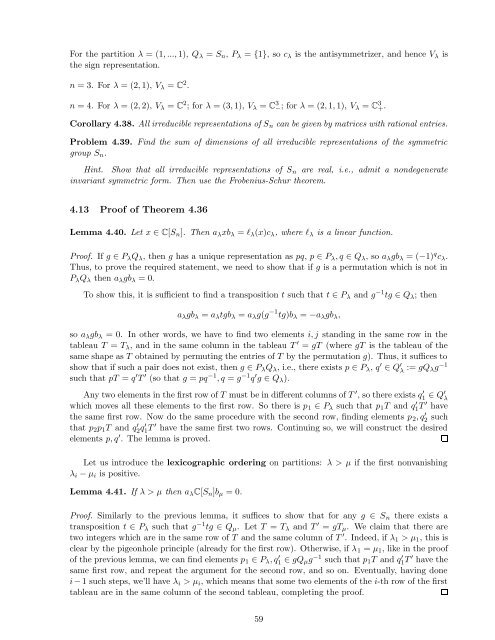Lecture notes for Introduction to Representation Theory
Lecture notes for Introduction to Representation Theory
Lecture notes for Introduction to Representation Theory
You also want an ePaper? Increase the reach of your titles
YUMPU automatically turns print PDFs into web optimized ePapers that Google loves.
For the partition ∂ = (1, ..., 1), Q = S n , P = {1}, so c is the antisymmetrizer, and hence V is<br />
the sign representation.<br />
n = 3. For ∂ = (2, 1), V = C 2 .<br />
n = 4. For ∂ = (2, 2), V = C 2 ; <strong>for</strong> ∂ = (3, 1), V = C 3 ; <strong>for</strong> ∂ = (2, 1, 1), V = C 3<br />
− +.<br />
Corollary 4.38. All irreducible representations of S n can be given by matrices with rational entries.<br />
Problem 4.39. Find the sum of dimensions of all irreducible representations of the symmetric<br />
group S n .<br />
Hint. Show that all irreducible representations of S n are real, i.e., admit a nondegenerate<br />
invariant symmetric <strong>for</strong>m. Then use the Frobenius-Schur theorem.<br />
4.13 Proof of Theorem 4.36<br />
Lemma 4.40. Let x C[S n ]. Then a xb = σ (x)c , where σ is a linear function.<br />
Proof. If g P Q , then g has a unique representation as pq, p P , q Q , so a gb = (−1) q c .<br />
Thus, <strong>to</strong> prove the required statement, we need <strong>to</strong> show that if g is a permutation which is not in<br />
P Q then a gb = 0.<br />
To show this, it is sufficient <strong>to</strong> find a transposition t such that t P and g −1 tg Q ; then<br />
a gb = a tgb = a g(g −1 tg)b = −a gb ,<br />
so a gb = 0. In other words, we have <strong>to</strong> find two elements i, j standing in the same row in the<br />
tableau T = T , and in the same column in the tableau T = gT (where gT is the tableau of the<br />
same shape as T obtained by permuting the entries of T by the permutation g). Thus, it suffices <strong>to</strong><br />
show that if such a pair does not exist, then g P Q , i.e., there exists p P , q Q<br />
<br />
:= gQ g −1<br />
such that pT = q T (so that g = pq −1 , q = g −1 q g Q ).<br />
Any two elements in the first row of T must be in different columns of T , so there exists q 1 Q<br />
<br />
which moves all these elements <strong>to</strong> the first row. So there is p 1 P such that p 1 T and q 1 T have<br />
the same first row. Now do the same procedure with the second row, finding elements p 2 , q<br />
2 such<br />
that p 2 p 1 T and q 2 q 1 T have the same first two rows. Continuing so, we will construct the desired<br />
elements p, q . The lemma is proved.<br />
Let us introduce the lexicographic ordering on partitions: ∂ > µ if the first nonvanishing<br />
∂ i − µ i is positive.<br />
Lemma 4.41. If ∂ > µ then a C[S n ]b µ = 0.<br />
Proof. Similarly <strong>to</strong> the previous lemma, it suffices <strong>to</strong> show that <strong>for</strong> any g S n there exists a<br />
transposition t P such that g −1 tg Q µ . Let T = T and T = gT µ . We claim that there are<br />
two integers which are in the same row of T and the same column of T . Indeed, if ∂ 1 > µ 1 , this is<br />
clear by the pigeonhole principle (already <strong>for</strong> the first row). Otherwise, if ∂ 1 = µ 1 , like in the proof<br />
of the previous lemma, we can find elements p 1 P , q 1<br />
<br />
gQ µ g −1 such that p 1 T and q 1 T have the<br />
same first row, and repeat the argument <strong>for</strong> the second row, and so on. Eventually, having done<br />
i − 1 such steps, we’ll have ∂ i > µ i , which means that some two elements of the i-th row of the first<br />
tableau are in the same column of the second tableau, completing the proof.<br />
59

















